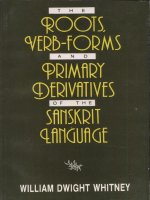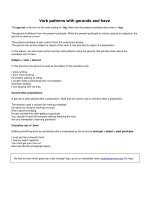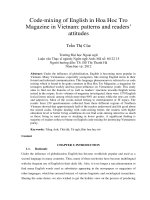Verb patterns and structures
Bạn đang xem bản rút gọn của tài liệu. Xem và tải ngay bản đầy đủ của tài liệu tại đây (10.91 KB, 1 trang )
Verb patterns and structures
English sentences follow certain patterns. In this section we will first consider some of the commonest verb
patterns and then some of the other important structures, both literary and conversational.
We have already learned that a sentence consists of two main parts –
the subject
and
the predicate
. The
subject must contain a noun or a pronoun. It may also contain other words like
articles
(a/an and the),
possessives
(my, your etc.) or
demonstratives
(this, that, these and those). The
predicate
must contain a verb.
Sometimes the subject is omitted and then we get one-word sentences.
Stop.
Who goes there?
Listen.
I want to tell you something.
Then there are sentences of two words – they just consist of a noun and an intransitive verb. Examples are:
Time flies. (Subject – time; verb – flies)
Water boils. (Subject – water; verb – boils)
Dogs bark. (Subject – dogs; verb – bark)
But we can’t get far with short sentences of this kind, so we will have to construct more elaborate sentence
patterns.
Sentence pattern 1
Subject Intransitive verb + adverb
Granny is coming on Monday.
A gentle breeze was blowing across the meadow.
The children are playing upstairs.
The sun has already risen.
The storm has at last subsided.
Notes
Adverbs
are words that provide information about the time, manner or place of the activity mentioned by the verb.
Adverbs may also indicate the frequency with which an action is done. Examples are: carefully, eagerly, anxiously
(manner), yesterday, soon, now, then, always (time and frequency), there, here, upstairs, somewhere (place).
Be first to know when grammar rules change! Sign up to our newsletter here: englishgrammar.org (It's free)
Powered by TCPDF (www.tcpdf.org)









